7.1 Lands
Lands of the Public Domain
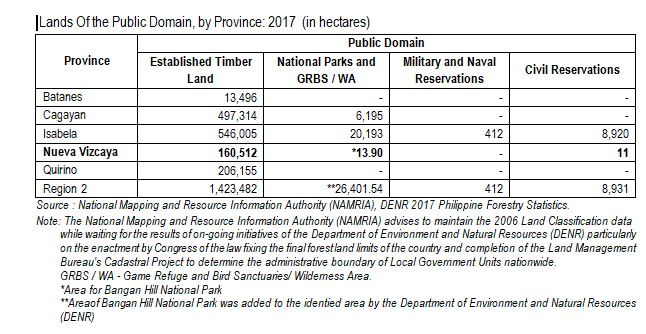
Based from the 2017 Philippine Forestry Statistics, Nueva Vizcaya has one of smallest areas established for timber production accounting to 11.28%(160,512 hectares) of the total established timber land in the region. Aside from Isabela, the province also has an area for Civil Reservations covering 11 hectares. No National Parks were identified by the Department of Environment and Natural Resources (DENR) within the province. Bangan Hill National Park with an area of 13.90 hectares was included in the table even though it was declared as Protected Area. No Military and Naval Reservations were registered in the province.
Private and Alienable and Disposable Lands

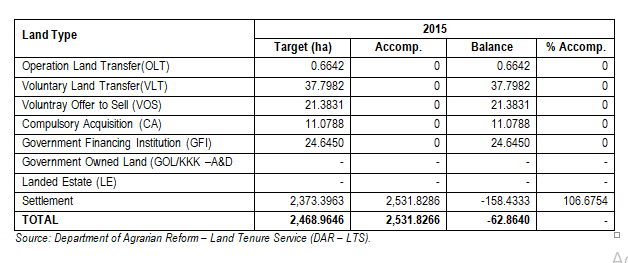
Ancestral Domain
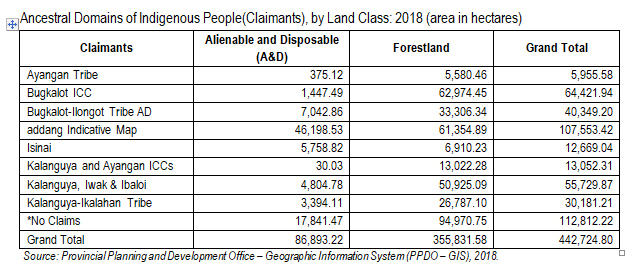
Forest land made up 80.37% of the total land area of the province. The remaining 19.63% on the other hand constitutes the Alienable and Disposable Land (A&D). About 73.31% or a total of 355,831.58 hectares of the total forest land area are part of the ancestral domain of 8 tribes and Indigenous Cultural Communities (ICC). The 26.69% equivalent to 94,970.75 hectares has no claims of Ancestral Domain. For the Alienable &Disposable land (A&D), the Gaddangs has the largest area with 46,498.83 hectares corresponding to 53.16% of the total A&D area. The portion of the total A&D area as part of the ancestral domains of the 7 ICCs and tribes accounted to 26.30%(22,853.21 hectares). The remaining 20.53% (17,841.47)of the total A&D area has no claims.
The claim of the Gaddangs accounted for the largest area which is 32.60% of the total surveyed area located in portions of Bayombong, Solano & Villaverde, Diadi, Quezon, Bagabag. In contrary, Ayangan Tribe claimed the smallest with 1.81% of the total corresponding to 5,955.58 hectares which is situated in portions of Bayombong, Solano and Villaverde.
7.2 Forest Lands
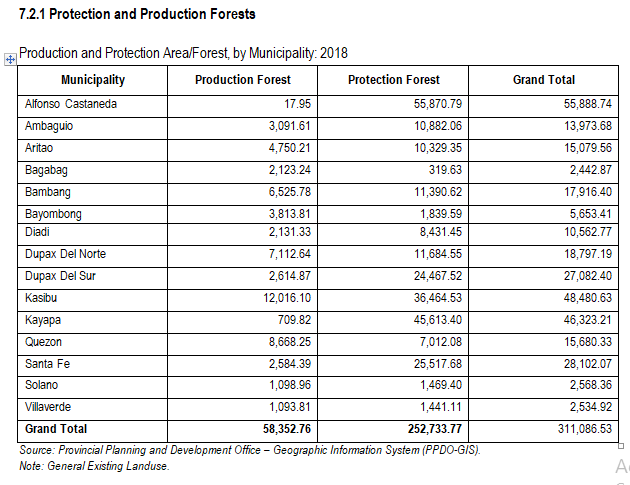
The area of the protection forest is considerably larger than that of the production forest. It comprised about 81.24% of the combined production and protection forest area. Alfonso Castañeda registered the largest protection forest with an area of 55,870.79 hectares or 22.11% of the total. Likewise, the municipality of Villaverde registered the lowest with 1,319.63 hectares only.
The production forest on the other hand made up 18.76% of the total. Of the mentioned portion, the largest are from the towns of Kasibu, Quezon ,Dupax del Norte and Bambang. In contrary, the smallest areas are from municipalities of Kayapa and Alfonso Castañeda.owed by commercial and industrial mainly because of the increase of households which needs domestic electrification.
7.3 Mineral Lands
Metallic Mineral Lands
Based on the GIS-generated data, the total mining tenements area in the province as of 2018 is 350,115.6 hectares under 58 holders. The largest metallic mineral land covered by the mining corporations is 47,443.86 hectares from the town of Bambang. This area is endowed with minerals such as Limestone,Manganese, Gold and Copper. On the other hand, the smallest areas for metallic extraction solely for limestone include towns of Solano and Villaverde which are both 4,805 hectares.

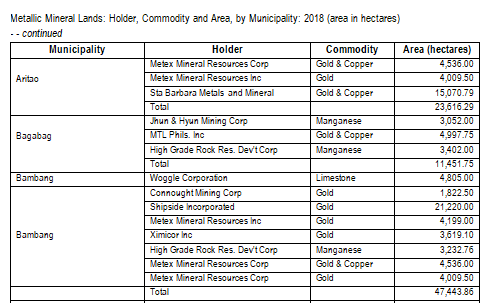
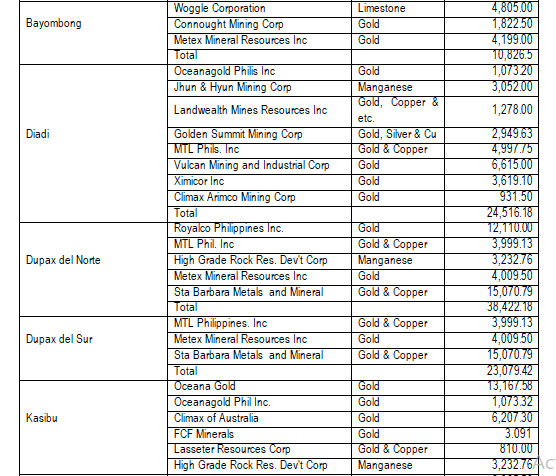

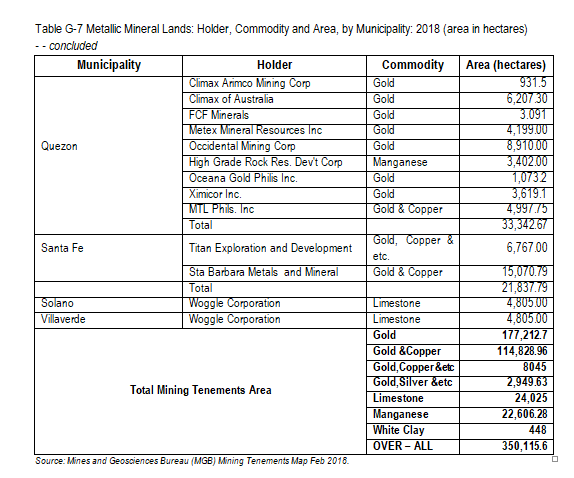
7.4 Parks, Wildlife And Other Reservations
Ten(10) protected areas namely Casecnan Protected Landscape, Pacugao Watershed Forest Reservation, Pantabangan Watershed Area, Dupax Protected Landscape, Pantabangan Caranglan Watershed Reservation, Salinas Natural Monument, Bangan Hill National Park, Ambuklao-Binga Upper Agno Watershed Reservation, Mount Pulag National Park, Balete Shrine and Talavera Watershed Reservation situated in eight (8) municipalities of the province are managed under the National Integrated Protected Areas System (NIPAS). The largest among the areas under the administrative jurisdiction of the Department of Environment and Natural Resources within the province is the Casecnan River Watershed Forest Reserve known as Casecnan Protected Landscape. Other reservations not included in the NIPAS are the Lower Magat and Eco-Tourism (LMET) in Diadi, Local Conservation Area (LCA) and Jose Rizal Park located in Bayombong.
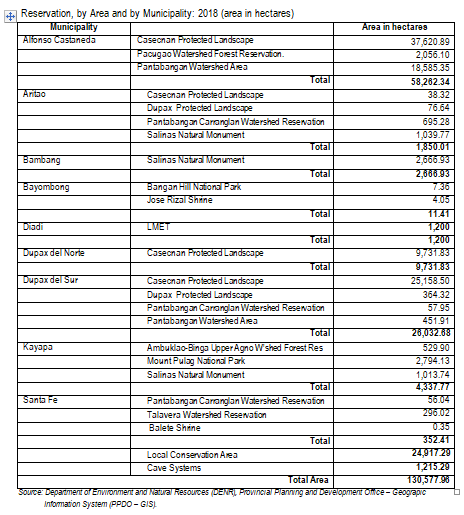
7.5 Water Resources
Agricultral Crops
Of the total land area of the province, only 47.85% or 211,838.52 hectares are potential area for groundwater and the remaining 52.15 %(230,886.29) are areas which are considered difficult areas for groundwater development. The largest groundwater potential area is listed under Kasibu with 40,156 hectares corresponding to 18.96% of the total potential area whilethe smallest is Santa Fe with 292.84 hectares or 0.14%.Top 3 largest sections that are considered difficult areas for groundwater development on the other hand includes the towns of Alfonso Castañeda, Santa Fe and Dupax del Sur which sums up to 102,407.35 hectares.
7.6 Waste Management
Solid Waste
Concerning the solid waste management facility, only 13 municipalities out of 15 have Materials Recovery Facility(MRF) excluding the towns of Diadi and Quezon, 9 with Vermi-Composting Facility(VRF), 9 with Sanitary Landfills(the other 6 are still on-going) and 8 with Residual Containment Areas(CRA). Similarly, all 15 towns have Solid Waste Management Plan. Also, 230 equivalently 84% of the target number of barangays have implemented their Materials Recovery Facilities(MRF).Likewise, 188 or 68% out of 275 barangays have Vermi-Composting Facility.
